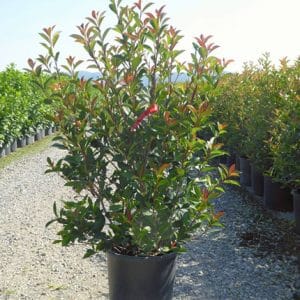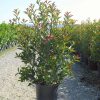The Red Tip Photinia Guide: Is This Vibrant Shrub Right for Your Texas Landscape?
 The Red Tip Photinia. A flash of crimson against the verdant landscape, these shrubs and small trees are a common sight in many Texas yards. Known for their vibrant red new growth that matures into a deep green, they offer a visual pop and a quick privacy screen. But are they the *right* choice for *your* garden?
The Red Tip Photinia. A flash of crimson against the verdant landscape, these shrubs and small trees are a common sight in many Texas yards. Known for their vibrant red new growth that matures into a deep green, they offer a visual pop and a quick privacy screen. But are they the *right* choice for *your* garden?
Before you rush out and fill your cart with these eye-catching plants, let’s delve into the story. This isn’t just another article singing the praises of the Red Tip Photinia. We’re here to give you the truth, exploring both the undeniable benefits and the potential drawbacks of planting this popular shrub.
Why are we doing this? Because informed decisions lead to happy gardens! We want you to choose plants that thrive in your specific environment and meet your unique needs.
In this guide, we’ll cover:
- The Alluring Pros: Discover the aesthetic appeal, rapid growth, and screening capabilities that make Red Tip Photinia so popular.
- Concerning Cons: Understand the potential disease susceptibility, maintenance requirements, and environmental considerations that often get overlooked.
- Growing Conditions: Learn the ideal soil, sunlight, and watering needs for optimal Red Tip Photinia growth.
- Alternatives: Explore other stunning shrubs and trees that might be a better fit for your landscape if Red Tip Photinia isn’t the perfect match.
Ready to Dig In? (Pun intended!) Let’s start with the good stuff…
The Pros of Planting Red Tip Photinia
- Instant Curb Appeal: That vibrant red new growth is undeniable. Red Tip Photinias offer a burst of color that instantly elevates the look of your property.
- Privacy in a Flash: Need a quick privacy screen? Red Tips grow relatively fast, providing a dense barrier that shields your yard from prying eyes.
- Easy to Shape: They respond well to pruning, allowing you to shape them into hedges, screens, or even small trees.
- Relatively Low Maintenance…at first: When healthy and established, they can be relatively low-maintenance (we’ll address the \”healthy\” part later).
The Cons of Red Tip Photinia
This is where things get real. Red Tip Photinias, while beautiful, are notorious for their susceptibility to a fungal disease called Entomosporium leaf spot.
- Entomosporium Leaf Spot: The Bane of Red Tips: This disease can cause unsightly spots on the leaves, premature leaf drop, and, in severe cases, even death.
- Constant Maintenance & Treatment: Preventing and managing Entomosporium requires diligent care, including proper watering techniques, regular pruning for air circulation, and often, fungicide applications. This isn’t a plant-and-forget option.
- Not Drought Tolerant: Unlike some Texas natives, Red Tip Photinias require regular watering, especially during dry periods.
- Potential for Overgrowth: If not pruned regularly, they can quickly become overgrown and unwieldy.
- Can Be Environmentally Problematic: Because of the prevalence of fungal issues, some people have needed to use toxic chemicals to maintain this shrub.
Growing Conditions for Red Tip Photinia
If, after considering the pros and cons, you decide that Red Tip Photinia is still the right choice for you, here are some tips for successful growth:
-
- Sunlight: They prefer full sun to partial shade (at least 6 hours of direct sunlight per day).
- Soil: Well-draining soil is essential. Amend heavy clay soils with compost and other organic matter.
- Watering: Water deeply and regularly, especially during the first year after planting. Avoid overhead watering, as this can encourage fungal diseases.
- Fertilizing: Fertilize in the spring with a balanced fertilizer.
- Pruning: Prune regularly to maintain shape and promote air circulation.
Alternatives to Red Tip Photinia
Not sold on Red Tip Photinia? Here are some excellent alternatives that offer similar benefits with fewer drawbacks:
- Nellie R. Stevens Holly: Evergreen with dense foliage and attractive red berries.
- Wax Myrtle: Fast-growing, drought-tolerant, and fragrant foliage.
- Elaeagnus: Silver-green foliage and fragrant flowers.
- Loropetalum (Chinese Fringe Flower): Offers similar red new growth but is generally more disease-resistant.
Red Tip Photinias can be a stunning addition to your Texas landscape, but it’s crucial to understand the potential challenges before you plant. Weigh the pros and cons carefully, consider your local climate and soil conditions, and be prepared to provide the necessary care and maintenance.
Looking for healthy, vibrant Red Tip Photinia or any of the excellent alternatives we discussed?
Visit Premier Nursery today! We have locations in Euless and Benbrook, Texas, staffed with knowledgeable experts who can help you choose the perfect plants for your garden.
We have a wide selection of high-quality Red Tip Photinias and a variety of other trees, shrubs, and plants to suit your needs. Our team can provide expert advice on planting, care, and disease prevention. We are waiting to help you create the garden of your dreams!



